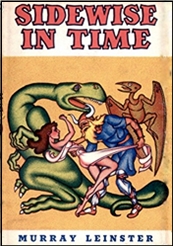Fri 21 Feb 2025
SF Stories I’m Reading: CLIFFORD D. SIMAK “Huddling Place.”
Posted by Steve under Science Fiction & Fantasy , Stories I'm Reading[7] Comments

CLIFFORD D. SIMAK “Huddling Place.” First appeared in Astounding SF, July 1944. Collected in City (Gnome Press, hardcover, 1952) and in Skirmish: The Great Short Fiction of Clifford D.Simak (Putnam’s, hardcover, 1977; Berkley, paperback, 1978). Reprinted in The Science Fiction Hall of Fame, Volume One, edited by Robert Silverberg (Doubleday, hardcover, 1970), among others.
Modern readers of SF and fantasy won’t remember Clifford Simak all that well, or even at all, but in his time, he was one of the lesser giants of the field. In my case, he was always one of my favorites, right up there with Robert A. Heinlein, Isaac Asimov and Arthur C. Clarke. Other authors came and went, but the stories of Mr. Simak have always stayed with me.

A lot of fans and critics have described his work as “pastoral,” and so it was, and it still is. It is so true that Simak himself uses the word to talk about his work at least twice in the foreword to his collection Skirmish (1977), of which “Huddling Place” is the lead story. (Don’t make too much about this statement: the stories are arranged in chronological order.)
But for example, the opening scene takes place in one of the most physically detailed settings for a funeral I can remember reader. It is of Jerome A. Webster’s father, who has recently died, leaving only Jerome, of a certain age himself, his son Thomas, now in his 20s, and his mother. These are the only remaining members of the Webster family, attended to only my robots, having moved a number of years ago from the city to this country estate where they now live.

And from which Jerome has come to realize he cannot leave. There is no need to. The story was written long before the Internet came along, but the equivalent exists when the tale takes place, and there is no need for him to leave. Not even to perform a life-saving operation on an old friend from Mars, which is where he lived for five years in his younger days.
He tries, and he is ready to, but as chance would have it, in a sad ending well worth waiting for, he cannot. And he probably won’t. Ever. Leave.
Interpretations I will leave for you. What I will say that this is a beautiful story, well deserving of its SF Hall of Fame status. Science fiction was growing up when this was published.








